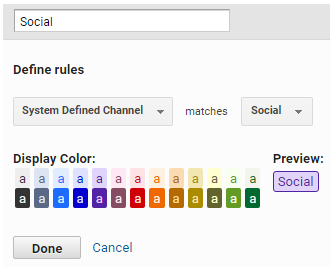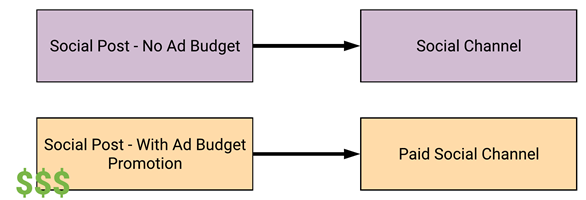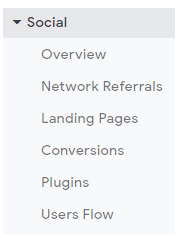Learn how to properly measure and report social media visitors using UTM parameters for Google Analytics.
What Sources does Google Analytics consider to be Social Media?
Way back in 2011 (so long ago…) Google announced a new initiative to improve Social Media reporting capabilities called the Social Data Hub. This hub was comprised of some of the most influential social networks and marked a change in considering all Social Media traffic as “referral” traffic and moved it into the Default Channel Group of Social. Times have changed, but these were the original social networks in the hub:
- Delicious
- Digg
- Diigo
- Gigya
- Google+
- Google Blogger
- Google Groups
- LiveFyre
- ReadItLater
- Vkontakte
- TypePad
Not long after there were a few more added:
- Blogger
- Digg
- Disqus
- Meetup
The shocker is that Facebook, LinkedIn, Pinterest, Twitter, Tumblr, Instagram, Snapchat, and many others were all missing. That meant some of the largest social media networks were left out as Google was trying to reposition its Google+ platform. And… we all know what happened to Google+. The social data hub has opened up, allowing us to accurately track virtually any social network that sends visitors to our site as long as we can add UTM parameters.
What do you consider to be the main Social Media platforms?
How about you?
The reason it’s important to define what Social means to your business is because a line needs to be drawn in the sand about the difference between Social and Referral traffic.
A referral channel traffic channel should be anything that you do not post, but that sends traffic to your website. It’s very similar actually to how Social sharing, re-tweeting, and re-posting work where someone still gives you the credit but they post on your behalf. So it’s important to define what sources, websites, etc. that you define are Social and what are Referral. A magazine, for example, might seem like it’s a Referral link, but it could be an affiliate or social media link to some businesses depending on the magazine.
You won’t be able to come up with a list of every single known Social or Referral link possible, but you can cover the basics or establish a standard so that going forward you will know what channel it needs.
Social – The Default Channel Grouping
By default, Google’s Default Channel Groupings can be found in your Google Analytics Admin settings under the View > Channel Settings > Channel Grouping. You’ll notice that the rule for social is a “System Defined Channel” that matches “Social” in the settings:
 You can add rules here as one way to suggest websites will fall into the “Social” channel. However, you will still need parameters in the URL to suggest the right kind of traffic is coming from a social post versus any other post.
You can add rules here as one way to suggest websites will fall into the “Social” channel. However, you will still need parameters in the URL to suggest the right kind of traffic is coming from a social post versus any other post.
The problem is that for most social networks, the same post could be used for “Organic” social and “Paid Social” simultaneously. For example, you can post a video on Facebook and then promote that post with advertisement budgets. In addition, you could have a post that you publish on Twitter that only appears as a Paid post, so you want that traffic to be attributed to a “Paid Social” channel and not the “Social” channel. See the diagram below for a visual of what you are looking for:

Before we get started…
First, before you go tweaking the Social Default Channel Grouping or creating a whole new one called, “Paid Social” you need to determine your use-cases for the data. In some circumstances, a company might not care at all to separate Social from Paid campaigns because at the end of the day, it’s all being aggregated anyway. I wouldn’t advocate for that because you lose a lot of contexts but it is important to consider what your company cares about before you go down this rabbit hole. Most (if not all changes) you make to your Google Analytics setup are permanent so decide carefully.
Second, before you make any changes, you must make sure that you have already added domains to the Referral Exclusion List. That list will make sure that traffic isn’t ending up in the “Referral” channel. The order of the channels in the Channel Groupings settings will determine the order that Google will sort traffic.
Last, you need to be using UTM parameters. Just looking at the referral is not enough to determine what channel visitors should be placed into. It’s recommended that you utilize UTM parameters in every link placed on outside websites that drives traffic to your website. That includes emails, mailers, advertisements, etc. All traffic coming to your website should fall into categories that you are familiar with.
Paid Social vs. Display or Other Advertising Channels
There are many ways to define Social traffic, and that has typically fallen into grouping all Social traffic into “Social,” separating unpaid Social from Paid Social, putting Paid Social into “Display,” or letting the “Other Advertising” channel pick it up. The choice has 100% to do with how your company wants to analyze and interpret the data.
Here is one example from our reporting, where we have one social and one paid:
 The most robust way is to add a new Channel, call it “Paid Social” or something to describe it, and then set up the rules to read it that way. I think putting that traffic into “Display” or “Other Advertising” is a half-measure, and letting it all funnel into Social is the fully aggregate approach.
The most robust way is to add a new Channel, call it “Paid Social” or something to describe it, and then set up the rules to read it that way. I think putting that traffic into “Display” or “Other Advertising” is a half-measure, and letting it all funnel into Social is the fully aggregate approach.
How granularly do you intend to measure your social media? (The more = more robust needed).
How much could advertising skew your social media results? (The more = more robust needed).
You decide, set it up, and then we will detail how to track those visitors into the right channels. The setup for his only requires that you have properly defined (by Source / Medium) what sources of traffic will fall into what Channel groupings.
How to track any Traffic using UTM Parameters
Whenever you post a link to your website into a social media post, advertisement, email, or put it on any material outside of your website, you should add the UTM parameters after the link in the URL. A UTM parameter is a set of data information that you tag onto links so that you know where you put it and why. It’s a way of keeping track of your links, so you know what sources of traffic are better than others.
Every link with UTM parameters must have the following:
- The utm_campaign – naming the campaign.
- The utm_source – defining the origin of the traffic.
- The utm_medium – labeling the type of format the traffic is coming from.
You can also include the following UTM parameters, but they are optional:
- The utm_content – specific details on the content (such as a/b test or grouping).
- The utm_term – the keywords/terms that matched for this to display.
The beauty of UTM parameters is that they can be anything you want them to be. Sure, there are standards that most analysts abide by but feel free to break the rules if you need to. The most important tips are as follows:
- √ You cannot have spaces in the values because this must work as a functioning URL.
- √ You cannot use special characters unless you HTML encode them.
- √ It’s recommended that all the values be lowercase.
- √ Do not repeat information across the values.
- √ KISS (keep it simple ‘silly’).
Here is a handy tool from Google to help you build out your UTMs.
You can go beyond the (5) UTM parameter fields above and create your own parameters and values (many marketing tools do this), but then you need to make sure that you clean up your URLs after.
For example, if a webpage loads as callsource.com/?id=123456 and the same page loads as callsource.com/?id=123457 then it will show as two row entries. Each row entry will say that only 1 user visited… even though we know that the page has two visitors. This mucks up your Google Analytics, so make sure you exclude or filter the extra parameters from your data to keep it clean.
How to track Social Traffic using UTM Parameters
When it comes to Social traffic, you simply need to pull out your handy list of Social Networks by the Source / Mediums that you setup in the steps above. Namely, anything you define as a “Social” channel by its Source / Medium you will use to label it in the utm_source and utm_medium UTM parameters.
Your utm_source UTM parameter should look like the following (depending on how you want to label it):
- √ utm_source=facebook
- √ utm_source=twitter
- √ utm_source=linkedin
- √ etc…
As for your utm_medium UTM parameter should look like the following (you define):
- utm_medium=social
(Note: I’ve also seen Facebook as facebook.com and twitter as t.co, so make sure you’re accounting for the alternative possibilities!)
Here is an example of the completed UTM portion of the link:
{link/}?utm_source=facebook&utm_medium=social&utm_campaign=web-posts-2019
The link above would tell you in Google Analytics:
Your campaign, “web-posts-2019” from the source / medium of, “facebook / social” brought in a user to your website. Again, I would reference Google’s handy UTM builder tool to get the basics.
How to see my Social Traffic in Google Analytics?
(Note: You might need to set up a Goal in your Google Analytics to see some of the Social reports – and e-commerce goals might not count.)
In your Google Analytics navigate to your Social Reports: GA > Acquisition > Social….
There are (currently as of mid-2019) six reports in Google Analytics under the Social tab. The six Social reports in Google Analytics are:

- Overview – Shows you the aggregate reporting tied to conversions (goals).
- Network Referrals – Shows you the session-spanning reporting of Social Networks that brought visitor traffic to your website.
- Landing Pages – Shows you the initial cookie’d webpage that someone from a Social Network first visited on your website.
- Conversions – Shows you the quantity and value (if you set it in the goal) of different Social Networks based on the amount of goal completions.
- Plugins – This shows you data from plugins that push social event data into Google Analytics (you must set this up with an integrated social sharing tool for your site).
- Users Flow – Shows you a Sankey diagram of the flow of users who originated from a Social Network and what pages they visited during the available sessions.
In addition, you can also see your Social Traffic in the All Traffic reports since you have set up your source / medium, UTM parameters, and configured your Default Channel Settings. Those reports will have Social as the default channel grouping, but you can also look up the traffic by any specific source / medium or UTM parameter you have used.
You can use the advanced search to look for a specific social network:

Or… you can look for any traffic visitors who came from the medium of social:

How do I measure Social performance to ROI?
As you use the reports in Google Analytics you can start to tie the traffic to Goals. The goals are what you set up as “Conversion” points such as form fills, phone calls, chats, etc. In most reports, such as the All Traffic reports, you will have that broken down for social by the different goals and their values:

Each traffic source will have the Goal Conversion Rate % (based on the users), the Goal Completions (based on the Goal rules), and the Goal Value (based on what you set in the goal summed up). If you have set up goals to have ROI values, then you can get your ROI there, but that is most often wishful thinking. Often a goal is simply a conversion earlier in the line like a form fill, a phone call, or a chat. It doesn’t always mean a purchase….
The beauty of having used UTM parameters, as shown above, is that you can actually track your form fills, your phone calls, and your chats (plus any other conversion type) along with the UTM parameters you’ve used. As long as that data is not destroyed, cookies not erased, or URL parameters deleted, then almost anyone can get this data at the point of conversion.
If you knew that person X, who called you last week, and became a customer today, came to your website because they saw post Y in LinkedIn, then you could put a dollar value on that campaign (even onto that post).
Not only that! If you knew that some posts generated higher value prospects for you, then you could learn which ones to boost with your advertisement budget. Plus you might learn that a social campaign is keeping customers from churning adding to retention value if there is a form fill, call, or chat along the way tying it back to users in your CRM.
How do we attribute conversions to Social campaigns?
At CallSource, we use our own product, EveryLead (it’s a Dynamic Number Insertion tool) to track visitors to our website, measure phone calls, push that data to Google Analytics, and attribute true ROI to Social media efforts. Phone calls are probably the most sophisticated conversion type to track, so if calls can be tracked, you can bet that forms, chats, and other forms are capable of tracking this as well.
With forms, you can use hidden fields that pull the UTM parameters right out of the URL and save them into your CRM when the form is submitted. For chats, they also can pick up the UTM parameters and save that when sync’d with your CRM.
The question then becomes… do we track the last-click attribution, the first-click attribution… etc. and at that point, you are way beyond this simple guide. I wish you the best in tracking your Social campaigns and efforts to ROI using Google Analytics. Please, if you have not already, I strongly urge you to start using UTM parameters as soon as possible.
If you have questions, ideas, or want to connect, feel free to reach out to us.
